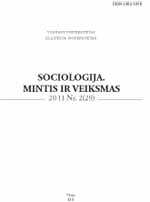Šeimos žemėlapio metodas
The Family Mapping Method
Author(s): Irena Juozeliūnienė, Laura KanapienienėSubject(s): Social Sciences
Published by: Vilniaus Universiteto Leidykla
Keywords: qualitative research; interview; vizualisation; triangulation; family
Summary/Abstract: The article presents the author’s analytical method for qualitative family mapping which was created by bringing together elements of psychology and sociology. Although created inductively, this method has two sources: Kvebaek’s sculpture technique and Jorgenson’s research into young families with children. The family mapping method is based on an open concept of the family, the ‘definition of situation’ and is associated with the interpretive tradition in sociology and symbolic interactionism. The gathering of the data includes three steps: listing, mapping and in-depth interviewing. Four characteristics of the method can be distinguished: visualisation of individual conceptualisations, the gathering of verbal and non-verbal information, triangulation within the method and the active (creative) participation of an individual. Examples from empirical data show that the method is contemporary and offers innovative tools for social research. However, the method’s advantages have implications both for the researcher and for research ethics.
Journal: Sociologija. Mintis ir Veiksmas
- Issue Year: 2011
- Issue No: 02
- Page Range: 35-54
- Page Count: 20
- Language: Lithuanian

